
This week I am listening to “What Went Down” by Foals
Somebody needs to think about this stuff...
by justin

This week I am listening to “What Went Down” by Foals
by justin
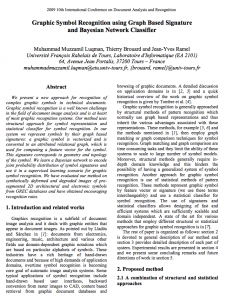
Graphic Symbol Recognition using Graph Based Signature and Bayesian Network Classifier
Today I read a published paper titled “Graphic Symbol Recognition using Graph Based Signature and Bayesian Network Classifier”
Interesting combination of a relational graph and a Bayesian network to recognise non-alphanumeric symbols in technical documents. As this is a reasonably hard problem to solve (or it was when I was doing that sort of thing about 20 years ago) it is encouraging to read new approaches (new for me anyway) to the problem. I wish the recognition rates (acknowledged in the paper) were a little higher.
The abstract:
We present a new approach for recognition of complex graphic symbols in technical documents. Graphic symbol recognition is a well known challenge in the field of document image analysis and is at heart of most graphic recognition systems. Our method uses structural approach for symbol representation and statistical classifier for symbol recognition. In our system we represent symbols by their graph based signatures: a graphic symbol is vectorized and is converted to an attributed relational graph, which is used for computing a feature vector for the symbol. This signature corresponds to geometry and topology of the symbol. We learn a Bayesian network to encode joint probability distribution of symbol signatures and use it in a supervised learning scenario for graphic symbol recognition. We have evaluated our method on synthetically deformed and degraded images of pre-segmented 2D architectural and electronic symbols from GREC databases and have obtained encouraging recognition rates.
by justin
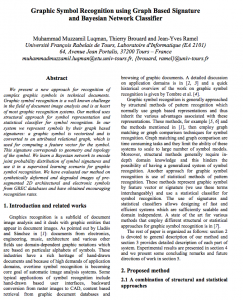
Graphic Symbol Recognition using Graph Based Signature and Bayesian Network Classifier
Today I read a published paper “Graphic Symbol Recognition using Graph Based Signature and Bayesian Network Classifier”
The abstract is:
We present a new approach for recognition of complex graphic symbols in technical documents. Graphic symbol recognition is a well known challenge in the field of document image analysis and is at heart of most graphic recognition systems. Our method uses structural approach for symbol representation and statistical classifier for symbol recognition. In our system we represent symbols by their graph based signatures: a graphic symbol is vectorized and is converted to an attributed relational graph, which is used for computing a feature vector for the symbol. This signature corresponds to geometry and topology of the symbol. We learn a Bayesian network to encode joint probability distribution of symbol signatures and use it in a supervised learning scenario for graphic symbol recognition. We have evaluated our method on synthetically deformed and degraded images of pre-segmented 2D architectural and electronic symbols from GREC databases and have obtained encouraging recognition rates.
by justin
“What we have here is a layer 8 issue, that is bleeding through in to layer 9. Seems the error code being generated has an ID of one zero Tango. That’s one of the more expensive problems to fix. We refer to it as a PICNIC.” says I.
“Why a PICNIC?” asks the client.
Without missing a beat, I retort, “You’ve heard of the problem P != NP complete? PICNIC is a useful acronym for remembering that. It’s a human factors issue.”
A few moments pass.
“Fantastic! When can you start?”
I think I just sold a steaming pile of BS.
by justin
Today I finished reading “Hello Startup. A Programmer’s Guide to Building Products, Technologies, and Teams” by Yevgeniy Brikman
by justin
Today I finished reading “Looking for Group #2” by Ryan Sohmer
by justin
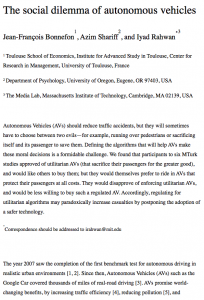
Autonomous Vehicles Need Experimental Ethics: Are We Ready for Utilitarian Cars?
Today I read a published paper “Autonomous Vehicles Need Experimental Ethics: Are We Ready for Utilitarian Cars?”
The abstract is:
The wide adoption of self-driving, Autonomous Vehicles (AVs) promises to dramatically reduce the number of traffic accidents. Some accidents, though, will be inevitable, because some situations will require AVs to choose the lesser of two evils. For example, running over a pedestrian on the road or a passer-by on the side; or choosing whether to run over a group of pedestrians or to sacrifice the passenger by driving into a wall. It is a formidable challenge to define the algorithms that will guide AVs confronted with such moral dilemmas. In particular, these moral algorithms will need to accomplish three potentially incompatible objectives: being consistent, not causing public outrage, and not discouraging buyers. We argue to achieve these objectives, manufacturers and regulators will need psychologists to apply the methods of experimental ethics to situations involving AVs and unavoidable harm. To illustrate our claim, we report three surveys showing that laypersons are relatively comfortable with utilitarian AVs, programmed to minimize the death toll in case of unavoidable harm. We give special attention to whether an AV should save lives by sacrificing its owner, and provide insights into (i) the perceived morality of this self-sacrifice, (ii) the willingness to see this self-sacrifice being legally enforced, (iii) the expectations that AVs will be programmed to self-sacrifice, and (iv) the willingness to buy self-sacrificing AVs.
by justin
This month I am studying “Baking Mastery – Baking and pastry”
This is a 48 month part-time course which I am completing at about 2x the speed so far. This is the 23rd and 24th months of study.
At the end of this month I will complete the forth certificate.
Update: Work intruded, I have bumped my certificate application until end of next month.
Update: Logged 56 hours of study and practice over the month. 48 hours of expected class time for two months, plus an extra 8 hours of practice on my own.
by justin

This week I am listening to “I Love You, Honeybear” by Father John Misty
by justin
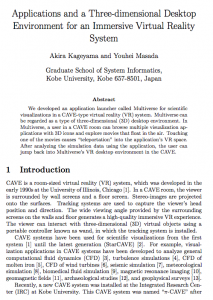
Applications and a Three-dimensional Desktop Environment for an Immersive Virtual Reality System
Today I read a published paper “Applications and a Three-dimensional Desktop Environment for an Immersive Virtual Reality System”
The abstract is:
We developed an application launcher called Multiverse for scientific visualizations in a CAVE-type virtual reality (VR) system. Multiverse can be regarded as a type of three-dimensional (3D) desktop environment. In Multiverse, a user in a CAVE room can browse multiple visualization applications with 3D icons and explore movies that float in the air. Touching one of the movies causes “teleportation” into the application’s VR space. After analyzing the simulation data using the application, the user can jump back into Multiverse’s VR desktop environment in the CAVE.
by justin
Potential Client (being very serious): “We were hoping for someone who had a bit more experience with developing games.”
P.S. I shipped my first video game in 1978, and they were aware of this.
by justin
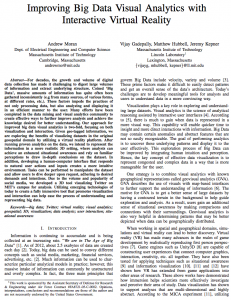
Improving Big Data Visual Analytics with Interactive Virtual Reality
Today I read a published paper “Improving Big Data Visual Analytics with Interactive Virtual Reality”
The abstract is:
For decades, the growth and volume of digital data collection has made it challenging to digest large volumes of information and extract underlying structure. Coined ‘Big Data’, massive amounts of information has quite often been gathered inconsistently (e.g from many sources, of various forms, at different rates, etc.). These factors impede the practices of not only processing data, but also analyzing and displaying it in an efficient manner to the user. Many efforts have been completed in the data mining and visual analytics community to create effective ways to further improve analysis and achieve the knowledge desired for better understanding. Our approach for improved big data visual analytics is two-fold, focusing on both visualization and interaction. Given geo-tagged information, we are exploring the benefits of visualizing datasets in the original geospatial domain by utilizing a virtual reality platform. After running proven analytics on the data, we intend to represent the information in a more realistic 3D setting, where analysts can achieve an enhanced situational awareness and rely on familiar perceptions to draw in-depth conclusions on the dataset. In addition, developing a human-computer interface that responds to natural user actions and inputs creates a more intuitive environment. Tasks can be performed to manipulate the dataset and allow users to dive deeper upon request, adhering to desired demands and intentions. Due to the volume and popularity of social media, we developed a 3D tool visualizing Twitter on MIT’s campus for analysis. Utilizing emerging technologies of today to create a fully immersive tool that promotes visualization and interaction can help ease the process of understanding and representing big data.
by justin
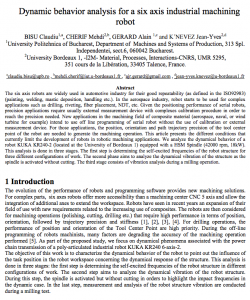
Dynamic behavior analysis for a six axis industrial machining robot
Today I read a published paper “Dynamic behavior analysis for a six axis industrial machining robot”
The abstract is:
The six axis robots are widely used in automotive industry for their good repeatability (as defined in the ISO92983) (painting, welding, mastic deposition, handling etc.). In the aerospace industry, robot starts to be used for complex applications such as drilling, riveting, fiber placement, NDT, etc. Given the positioning performance of serial robots, precision applications require usually external measurement device with complexes calibration procedure in order to reach the precision needed. New applications in the machining field of composite material (aerospace, naval, or wind turbine for example) intend to use off line programming of serial robot without the use of calibration or external measurement device. For those applications, the position, orientation and path trajectory precision of the tool center point of the robot are needed to generate the machining operation. This article presents the different conditions that currently limit the development of robots in robotic machining applications. We analyze the dynamical behavior of a robot KUKA KR240-2 (located at the University of Bordeaux 1) equipped with a HSM Spindle (42000 rpm, 18kW). This analysis is done in three stages. The first step is determining the self-excited frequencies of the robot structure for three different configurations of work. The second phase aims to analyze the dynamical vibration of the structure as the spindle is activated without cutting. The third stage consists of vibration analysis during a milling operation.
by justin
It is not an opinion, if you are right.
by justin
Why do you have so many separate blogs asked the person who was researching me.
“Because when I open a cook book I expect to see recipes, not a deeply interesting read on marketing your app in emerging markets and how to A/B test user acquisitions.” I replied.
by justin
Every man comes to the Lloyd in his own way.
by justin

This week I am listening to “Something More Than Free” by Jason Isbell
by justin
Imagine if every house in your neighbour triggered an hour long alarm every time someone walked past or approached the front door.
How annoying that would be.
I think we should just straight up outlaw car alarms.
Or make it so that they are only allowed to trigger if a window is broken or a door is physically opened with the alarm engaged.
by justin
5:30AM and a technical recruiter calls me: “Hey, this is Angie for ABC Recruiting. I found your resume online and it is a perfect match for junior .NET developer in Florida. When can I schedule you for an interview?”
Me: “There is not enough coffee in the world that could get me to wake up in the morning to tolerate your special kind of bullshit.”
*click*
by justin
“Here’s a link to 40 hours of video of an advanced software development class I teach to senior engineers at [name drop of well-known company in Cupertino]. A link to a 30 minute video where I live code a random audience question in class. My github repo of 20+ Open Source projects I authored. My software development blog. My blog I write on startups and marketing. Links to learned articles in trade journals where I talk about leadership, engineering, and solving hard problems.”
“That all sounds great. Before we do a phone screen, could you take this HackerRank test? Should only take a few hours.”
People not in your line of work are not qualified to evaluate you.
by justin
Think about this…
There are children living in one of the most advanced societies in the world eating nothing but takeout or food that didn’t solely come from a box.
There are children who do not know what it is like to eat a meal where a large proportion of the food did not come from a can or a box.
There are children who do not know what it is like to eat a meal where everything was prepared from the basic ingredients.
When will the kitchen, the physical room, be considered an obsolete concept and just disappear from modern dwellings?
by justin
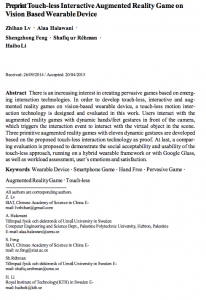
Touch-less Interactive Augmented Reality Game on Vision Based Wearable Device
Today I read a published paper “Touch-less Interactive Augmented Reality Game on Vision Based Wearable Device”
The abstract is:
There is an increasing interest in creating pervasive games based on emerging interaction technologies. In order to develop touch-less, interactive and augmented reality games on vision-based wearable device, a touch-less motion interaction technology is designed and evaluated in this work. Users interact with the augmented reality games with dynamic hands/feet gestures in front of the camera, which triggers the interaction event to interact with the virtual object in the scene. Three primitive augmented reality games with eleven dynamic gestures are developed based on the proposed touch-less interaction technology as proof. At last, a comparing evaluation is proposed to demonstrate the social acceptability and usability of the touch-less approach, running on a hybrid wearable framework or with Google Glass, as well as workload assessment, user’s emotions and satisfaction.
by justin
Today I read a published paper titled “Coordination Games on Graphs”
Nothing to add. I need to dwell on it. Just knowledge for the sake of it.
The abstract is:
We introduce natural strategic games on graphs, which capture the idea of coordination in a local setting. We show that these games have an exact potential and have strong equilibria when the graph is a pseudoforest. We also exhibit some other classes of graphs for which a strong equilibrium exists. However, in general strong equilibria do not need to exist. Further, we study the (strong) price of stability and anarchy. Finally, we consider the problems of computing strong equilibria and of determining whether a joint strategy is a strong equilibrium.
by justin
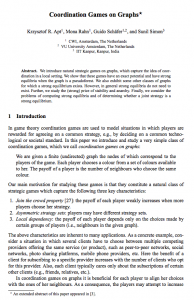
Coordination Games on Graphs
Today I read a published paper “Coordination Games on Graphs”
The abstract is:
We introduce natural strategic games on graphs, which capture the idea of coordination in a local setting. We show that these games have an exact potential and have strong equilibria when the graph is a pseudoforest. We also exhibit some other classes of graphs for which a strong equilibrium exists. However, in general strong equilibria do not need to exist. Further, we study the (strong) price of stability and anarchy. Finally, we consider the problems of computing strong equilibria and of determining whether a joint strategy is a strong equilibrium.
by justin
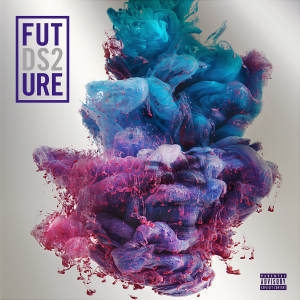
This week I am listening to “DS2” by Future
by justin
I swear that the functionality of LinkedIn is actually in regression.
You can no longer search your connections for location.
I’m wondering if they are taking a leaf out of Electronic Arts playbook.
Cannot wait for LinkedIn to release their DLC pack and Season Pass.
by justin
Beaver Builder and WP Types have suddenly become my two favouritest WordPress plugins.
Throw in Underscores theme and I don’t think I need to spin up Drupal instances for “those sites that don’t quite fit in the WordPress mould.”
by justin
I have inherited some iOS code for a client app from the previous developer.
If I see one more hard-coded magic number or yet another comment that says “declare the variables!!!” or another comment that says “set a constant value to 10” followed by a line of code that reads “var someValue = 12” I swear I will hunt down that developer and say some very stern words.
by justin
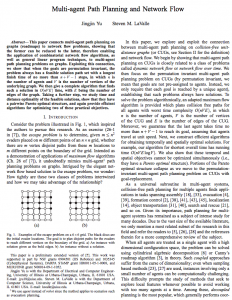
Multi-agent Path Planning and Network Flow
Today I read a published paper “Multi-agent Path Planning and Network Flow”
The abstract is:
This paper connects multi-agent path planning on graphs (roadmaps) to network flow problems, showing that the former can be reduced to the latter, therefore enabling the application of combinatorial network flow algorithms, as well as general linear program techniques, to multi-agent path planning problems on graphs. Exploiting this connection, we show that when the goals are permutation invariant, the problem always has a feasible solution path set with a longest finish time of no more than $n + V – 1$ steps, in which $n$ is the number of agents and $V$ is the number of vertices of the underlying graph. We then give a complete algorithm that finds such a solution in $O(nVE)$ time, with $E$ being the number of edges of the graph. Taking a further step, we study time and distance optimality of the feasible solutions, show that they have a pairwise Pareto optimal structure, and again provide efficient algorithms for optimizing two of these practical objectives.
by justin
A bureaucracy may appear to be unassailable, but it is persistence that beats it every time.
by justin

This week I am listening to “Beauty Behind The Madness” by The Weeknd
by justin
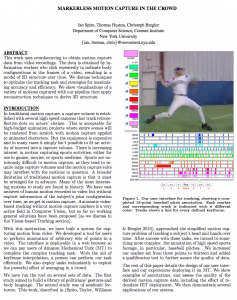
Markerless Motion Capture in the Crowd
Today I read a published paper “Markerless Motion Capture in the Crowd”
The abstract is:
This work uses crowdsourcing to obtain motion capture data from video recordings. The data is obtained by information workers who click repeatedly to indicate body configurations in the frames of a video, resulting in a model of 2D structure over time. We discuss techniques to optimize the tracking task and strategies for maximizing accuracy and efficiency. We show visualizations of a variety of motions captured with our pipeline then apply reconstruction techniques to derive 3D structure.
by justin
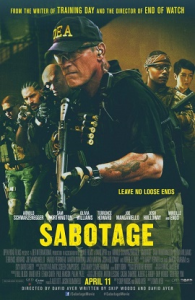
Today I watched “Sabotage”
It was… predictably bad. Classic 19080’s Schwarzenegger though.
by justin

Today I watched “The Blind Swordsman: Zatoichi”
Stylised Japanese sword drama. Entertaining. Some tense dramatic moments but mostly lighthearted throughout.
by justin
Woohoo!
I’ve finally lost the fourth Fitbit and my wife has conceded that perhaps we shouldn’t replace it this time.
by justin
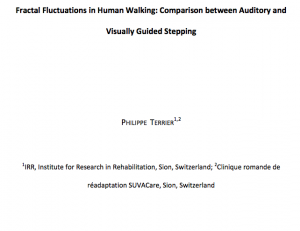
Fractal Fluctuations in Human Walking: Comparison between Auditory and Visually Guided Stepping
Today I read a published paper “Fractal Fluctuations in Human Walking: Comparison between Auditory and Visually Guided Stepping”
The abstract is:
In human locomotion, sensorimotor synchronization of gait consists of the coordination of stepping with rhythmic auditory cues (auditory cueing, AC). AC changes the long-range correlations among consecutive strides (fractal dynamics) into anti-correlations. Visual cueing (VC) is the alignment of step lengths with marks on the floor. The effects of VC on the fluctuation structure of walking have not been investigated. Therefore, the objective was to compare the effects of AC and VC on the fluctuation pattern of basic spatiotemporal gait parameters. Thirty-six healthy individuals walked 3 x 500 strides on an instrumented treadmill with augmented reality capabilities. The conditions were no cueing (NC), AC, and VC. AC included an isochronous metronome. In VC, projected stepping stones were synchronized with the treadmill speed. Detrended fluctuation analysis assessed the correlation structure. The coefficient of variation (CV) was also assessed. The results showed that AC and VC similarly induced a strong anti-correlated pattern in the gait parameters. The CVs were similar between the NC and AC conditions but substantially higher in the VC condition. AC and VC probably mobilize similar motor control pathways and can be used alternatively in gait rehabilitation. However, the increased gait variability induced by VC should be considered.
by justin
Today I read a published paper entitled “Fractal Fluctuations in Human Walking: Comparison between Auditory and Visually Guided Stepping”
I have no idea what I am going to do with this knowledge. However, it has given me an idea for two pieces of augmented reality exercise equipment that could be used to motivate people to work out more.
A punching bag with AR projection that designates targets to hit, rapid punches to throw, etc.
An AR treadmill that can project where you should put your foot and coupled with gait analysis, can predict your overall cardio fitness and making estimates of how fast you could run a marathon.
The abstract is:
In human locomotion, sensorimotor synchronization of gait consists of the coordination of stepping with rhythmic auditory cues (auditory cueing, AC). AC changes the long-range correlations among consecutive strides (fractal dynamics) into anti-correlations. Visual cueing (VC) is the alignment of step lengths with marks on the floor. The effects of VC on the fluctuation structure of walking have not been investigated. Therefore, the objective was to compare the effects of AC and VC on the fluctuation pattern of basic spatiotemporal gait parameters. Thirty-six healthy individuals walked 3 x 500 strides on an instrumented treadmill with augmented reality capabilities. The conditions were no cueing (NC), AC, and VC. AC included an isochronous metronome. In VC, projected stepping stones were synchronized with the treadmill speed. Detrended fluctuation analysis assessed the correlation structure. The coefficient of variation (CV) was also assessed. The results showed that AC and VC similarly induced a strong anti-correlated pattern in the gait parameters. The CVs were similar between the NC and AC conditions but substantially higher in the VC condition. AC and VC probably mobilize similar motor control pathways and can be used alternatively in gait rehabilitation. However, the increased gait variability induced by VC should be considered.
by justin
This month I am studying “Classical European cuisines”
48 months part-time. 21st and 22nd month
Update: Logged 66 hours in practice this month. I’ve got well over 900 hours of instruction and practice in so far.
by justin

This week I am listening to “Wildheart” by Miguel
by justin

Emotion Detection from Text
Today I read a published paper “Emotion Detection from Text”
The abstract is:
Emotion can be expressed in many ways that can be seen such as facial expression and gestures, speech and by written text. Emotion Detection in text documents is essentially a content – based classification problem involving concepts from the domains of Natural Language Processing as well as Machine Learning. In this paper emotion recognition based on textual data and the techniques used in emotion detection are discussed.
by justin
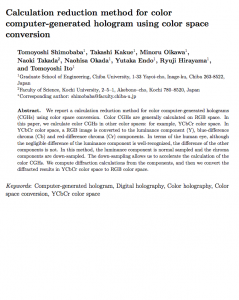
Calculation reduction method for color computer-generated hologram using color space conversion
Today I read a published paper “Calculation reduction method for color computer-generated hologram using color space conversion”
The abstract is:
We report a calculation reduction method for color computer-generated holograms (CGHs) using color space conversion. Color CGHs are generally calculated on RGB space. In this paper, we calculate color CGHs in other color spaces: for example, YCbCr color space. In YCbCr color space, a RGB image is converted to the luminance component (Y), blue-difference chroma (Cb) and red-difference chroma (Cr) components. In terms of the human eye, although the negligible difference of the luminance component is well-recognized, the difference of the other components is not. In this method, the luminance component is normal sampled and the chroma components are down-sampled. The down-sampling allows us to accelerate the calculation of the color CGHs. We compute diffraction calculations from the components, and then we convert the diffracted results in YCbCr color space to RGB color space.
by justin
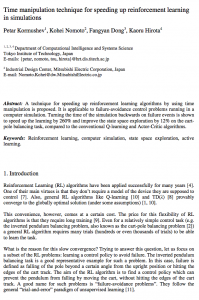
Time manipulation technique for speeding up reinforcement learning in simulations
Today I read a published paper “Time manipulation technique for speeding up reinforcement learning in simulations”
The abstract is:
A technique for speeding up reinforcement learning algorithms by using time manipulation is proposed. It is applicable to failure-avoidance control problems running in a computer simulation. Turning the time of the simulation backwards on failure events is shown to speed up the learning by 260% and improve the state space exploration by 12% on the cart-pole balancing task, compared to the conventional Q-learning and Actor-Critic algorithms.
by justin
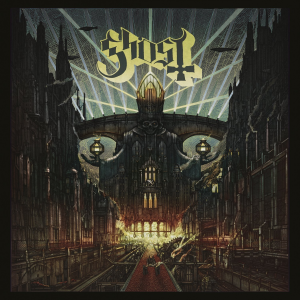
This week I am listening to “Meliora” by Ghost B.C.
by justin
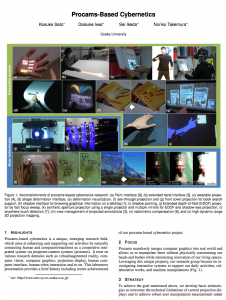
Procams-Based Cybernetics
Today I read a published paper “Procams-Based Cybernetics”
The abstract is:
Procams-based cybernetics is a unique, emerging research field, which aims at enhancing and supporting our activities by naturally connecting human and computers/machines as a cooperative integrated system via projector-camera systems (procams). It rests on various research domains such as virtual/augmented reality, computer vision, computer graphics, projection display, human computer interface, human robot interaction and so on. This laboratory presentation provides a brief history including recent achievements of our procams-based cybernetics project.
by justin
Go to bed at 6AM.
Get out of bed at 1PM.
Cut and colour someone’s hair.
Make bread dough for dinner tonight.
Feed household animals and colony of strays across the street.
Walk dog.
Tend to an injured cat.
Debug a broken piece of code for someone.
Pull a couple of Cappuccinos.
Do a little project management.
And some client management.
Write up two quick marketing blurbs for my website.
My life is dull, but the dull parts of kind of interesting when taken in isolation.
by justin
I do not know how I ever lived without the HumanScale M8 monitor arms.
So much desk space.
So few monitor stands cluttering up the place.
by justin
“I am surprised you are making an apple pie, you hate apple pie.” said the in-law.
“No, I fucking love apple pie.” I replied. “I hate American apple pie.”
“What’s the difference?”
“American apple pie is an overly sweet confection with no depth of taste and utterly lacking in character ruined by that most accursed spice of American households everywhere.”
“Oh that’s right, I forgot you hate cinnamon.”
“No, I fucking love cinnamon. I just don’t think it should be used in every dessert, dish or drink between Oct 1st and January 1st as though the entire country simultaneously forgot how to cook.”
Two weeks later. Same in-law.
“Don’t eat that, you won’t like it, it has cinnamon in it and I know how much you hate cinnamon.”
by justin
No matter how many video monitors are connected to your workstation there is never enough screen real-estate for working on a spreadsheet.
by justin

This week I am listening to “Man It Feels Like Space Again” by Pond
by justin

Parking Space Management via Dynamic Performance-Based Pricing
Today I read a published paper “Parking Space Management via Dynamic Performance-Based Pricing”
The abstract is:
In congested urban areas, it remains a pressing challenge to reduce unnecessary vehicle circling for parking while at the same time maximize parking space utilization. In observance of new information technologies that have become readily accessible to drivers and parking agencies, we develop a dynamic non-cooperative bi-level model (i.e. Stackelberg leader-follower game) to set parking prices in real-time for effective parking access and space utilization. The model is expected to fit into an integrated parking pricing and management system, where parking reservations and transactions are facilitated by sensing and informatics infrastructures, that ensures the availability of convenient spaces at equilibrium market prices. It is shown with numerical examples that the proposed dynamic parking pricing model has the potential to virtually eliminate vehicle circling for parking, which results in significant reduction in adverse socioeconomic externalities such as traffic congestion and emissions.